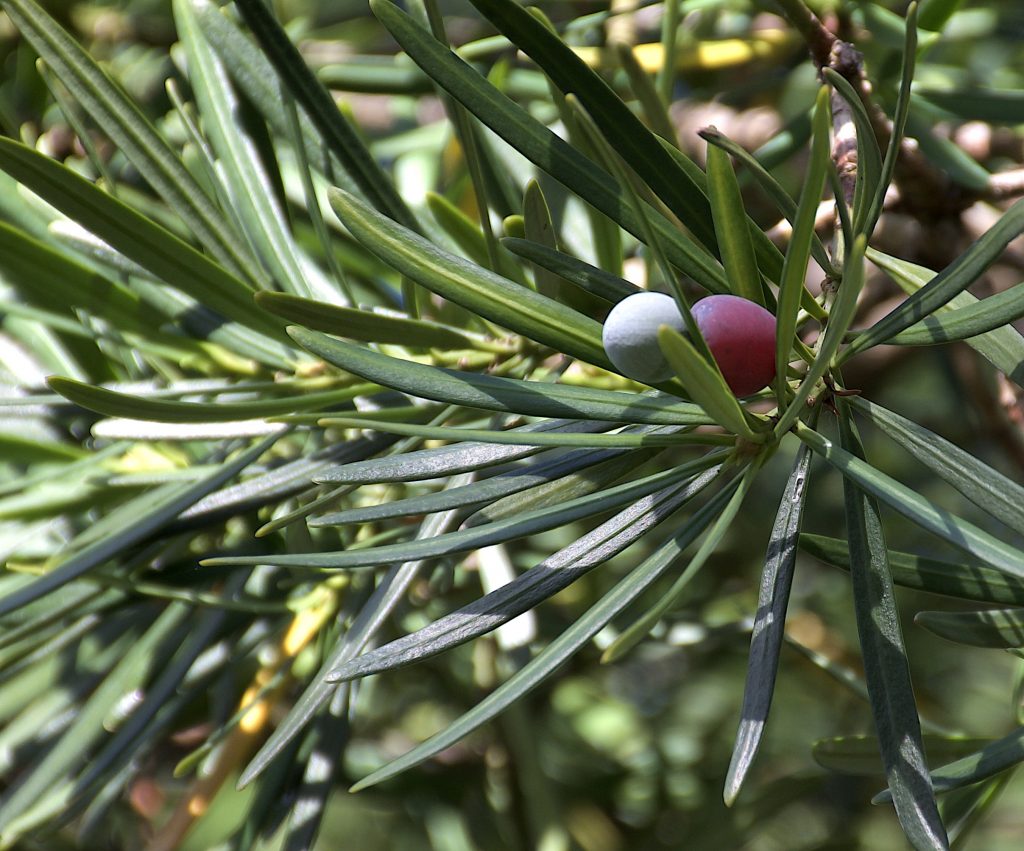
Can you identify what’s wrong with this picture? See below. Photo by Green Deane
Actually there’s nothing wrong with the photo per se, it’s the time of year that’s different. Usually Podocaprus develop non-edible seeds with their edible aril around early August, give or take a week or two. That’s the seasonal mother load so to speak. But for several years I have noticed four Podocarpus trees fruiting near Christmas time. I have also spied one hedge doing the same not far away. As the weather varies year to year I can’t really say that is the cause. My next choice is different species. That might account for it. Thus while we usually harvest the arils in August we have a yuletide treat when I do my free Urban Crawl near these trees December 18th. To read more about Podocarpus go here.
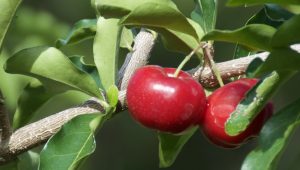
A local city has added an edible to their downtown park. Photo by Green Deane
Shall I craft an alliteration and say I saw an exciting sighting this week in Winter Park? A while ago in their downtown park they removed a Limequat leaving the space empty. I have no idea why the tree had to go in that it was regularly fruiting and while not rare a novelty. It has been replaced by a Acerola Cherry also called Barbados Cherry. This little tree’s claim to fame is a huge amount of acorbic acid which is natural vitamin C. Each fruit has several times your daily need for vitamin C. This tree has been fruiting and I noticed the fruit was not being picked up. This is a common sight. I routinely see fruit rotting on the ground. This includes mangos, star fruit, loquats, citrus, apples and now Acerola Cherries. I have an article about them waiting to be published.

Classes are held rain or shine or cold. (Hurricanes are an exception.) Photo by Kelly Fagan.
Foraging Classes: A foraging class in my backyard so to speak Saturday then one in New Port Richey Sunday.
Saturday, December 5th, Blanchard Park, 10501 Jay Blanchard Trail, Orlando, FL 32817. 9 a.m. to noon. Meet at the pavilion next to the tennis courts next to the YMCA building.
Sunday, December 6th, John Chestnut County Park, 2200 East Lake Road, Palm Harbor, FL 34685. 9 a.m. to noon. Meet at the trail head of the Peggy Park Nature Walk, pavilion 1 parking lot.
Saturday, December 12th, Dreher Park, 1200 Southern Blvd., West Palm Beach, 33405. 9 a.m. to noon. Take exit 68 (Southern Boulevard) off Interstate 95 and go east. Entrance to the park is an immediate right at the bottom of the interstate bridge. Follow the convoluted signs to the science center (which is not where the GPS puts you.) Park anywhere. We meet 300 feet northwest of the science museum near the banyan tees.
Sunday, December 13th, Turtle Mound: Canaveral National Seashore Park, New Smyrna Beach Fl. 9 a.m. to noon. A foraging class at this location requires some flexibility. There is a fee to get into the park. We start at Turtle Mound but there is limited parking. However, there is a ranger station visitor center just south of the mound with parking there, too. After the mound we will drive to the next beachside parking area to look around. Then we move a second time to visit what is left of Eldora once a busy town on the inland waterway.
Saturday, December 19th, Bayshore Live Oak Park, Port Charlotte, 9 a.m. to noon. Meet at the parking lot at the intersection of Bayshore and Ganyard Street.
Sunday, December 20th, Mead Gardens, 1500 S. Denning Dr., Winter Park, FL 32789. 9 a.m. to noon. The entrance is on the west side off Denning not the east side off Pennsylvania. Some GPS maps are wrong. Meet near the bathrooms.
Sunday, December 27th, Ft. Desoto Park, 3500 Pinellas Bayway S. St. Petersburg Fl 33715. 9 a.m. to noon. There is an entrance fee to the park. After you enter the park you arrive at a T-intersection. Turn right. Close to a mile later on your left is the fishing pier and parking lot. Meet near the bathrooms. There is considerable walking at this location.
For more information, to pre-pay or sign up for a class go here.
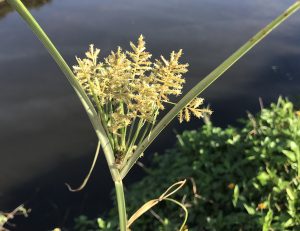
What to do. It looks like Yellow Nut Sedge but smells like Purple Nut Sedge.
Often when foraging something you aren’t looking for suddenly pops up. That happed Sunday in Sarasota. Actually two plants appeared, Chufa, and Redflowered Ragweed mentioned below. For a common plant I don’t see Chufa too often or more specifically when I find the plant and dig there are no nutlets attached. Sunday it was different. We saw the lesser of the two Cypurus rotundus. It’s easy to identify. The nutlets and underground parts of the plant smell like Vick’s Vapor Rub. C. esculentus does not. That latter has been cultivated for thousands of years as a food crop and is found worldwide. The problem was this looks like the Yellow Nut Sedge but smelled like the Purple Nut Sedge. And… one of the problems in Florida when it comes to identifying sedges is that there are over 100 species of Cypurus. You can read about them here.
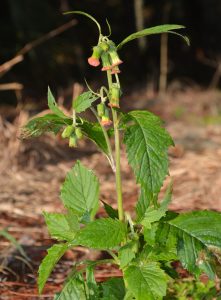
Redflowered Ragweed. Photo by Green Deane
Redlfower Ragweed isn’t a ragweed but I’ve been seeing it for a couple of years now. It reminds me of Fireweed/Burnweed except with red blossoms. Botanically it’s Crassocephalum crepidioides (kras-oh-SEF-uh-lum krep-pid-dee-OY-deez.) Crassocephalum is from the Dead Latin “Crassus” meaning “thick” and “kephale” which is Greek for head. Crepidioides is more mangle Greek. “-oides” in Dead Latin is mispronounced borrowed Greek and means “resembles.” Crepidioides means “resembles Crepis.” Crepis is from an old Greek word for a frilly funeral veil. It works its way into English via French as “crepe” paper. So “thick head resembles crepe paper” is one way to interpret the plant’s name.” And… even though it is called the Redflower Ragweed its leaves more resemble Fireweed/Burnweed, Erechtites hieraciifolius (which is an even more complicated, naughty story.) Redflower Rageweed’s blossoms, however, more resemble the toxic Florida Tassel Flower. Cornucopia II says of Crassocephalum crepidioides on page 37: “Ebolo, Okinawan Spinach, Young leaves and shoots are used as a potherb, fried, or mixed in Khao yam. The leaves are fleshy, tinged with purple and have a somewhat mucilaginous quality and nutty flavor. Has become quite popular on the island of Okinawa and in Hawaii In Thailand, the roots are eaten with chili sauce or cooked in fish curry. Tropical Africa. Cultivated.”
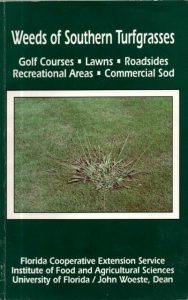
Weeds of Southern Turfgrasses.
For many years an inexpensive book published by the state of Florida was also a good foraging identification book. Unintentionally I’m sure, about 75% of the plants in the $8 book were edible. I posted a list on my website so folks could identify which one. Apparently the book went out of print but it is free on line here. Just open then down load the page. Then to get a list of what is edible in the book go here. We have Rose-Ann to thank for this. She found and reported this free edition. I note that a lot of folks are selling the book for forty-some dollars on the internet and one was asking $102.

Green Deane videos are now available on a USB.
A 150-video USB or 135 video DVD set would be a good winter present and either is now $99. My nine-DVD set of 135 videos has been selling for seven years and are still available. They are the same videos I have on You Tube. Some people like to have a separate copy. A second option is a16-gig USB that has those 135 videos plus 15 more. While the videos can be run from the DVDs the videos on the USB have to be copied to your computer to play. They are MP4 files. The150-video USB is $99 and the 135-video DVD set is now $99. The DVDs will be sold until they run out then will be exclusively replaced by the USB. This is a change I’ve been trying to make for several years. So if you have been wanting the 135-video DVD set order it now as the price is reduced and the supply limited. Or you can order the USB. My headache is getting my WordPress Order page changed to reflect these changes. We’ve been working on it for several weeks. However, if you want to order now either the USB or the DVD set make a $99 “donation” using the link at the bottom of this page or here. That order form provides me with your address, the amount — $99 — tells me it is not a donation and in the note say if you want the DVD set or the USB.

Green Deane Forum
Want to identify a plant? Perhaps you’re looking for a foraging reference? You might have a UFO, an Unidentified Flowering Object, you want identified. On the Green Deane Forum we — including Green Deane and others from around the world — chat about foraging all year. And it’s not just about warm-weather plants or just North American flora. Many nations share common weeds so there’s a lot to talk. There’s also more than weeds. The reference section has information for foraging around the world. There are also articles on food preservation, and forgotten skills from making bows to fermenting food.
This is weekly newsletter #434. If you want to subscribe to this free newsletter you can find the sign-up form in the menu at the top of the page.
To donate to the Green Deane Newsletter click here.


Although the Cypurus esculentus – edible and useful in many respects – their harm regarding the ornamental aspect of piches is well known. I personally changed the pH of my pitch’s soil using various ranges with no avail.l’ve come across a research eradicating the tubers with isothiocyanates. Please refer to the abstract: https://10.1111/j.1445-6664.0028x
Can one suggest a safe method?